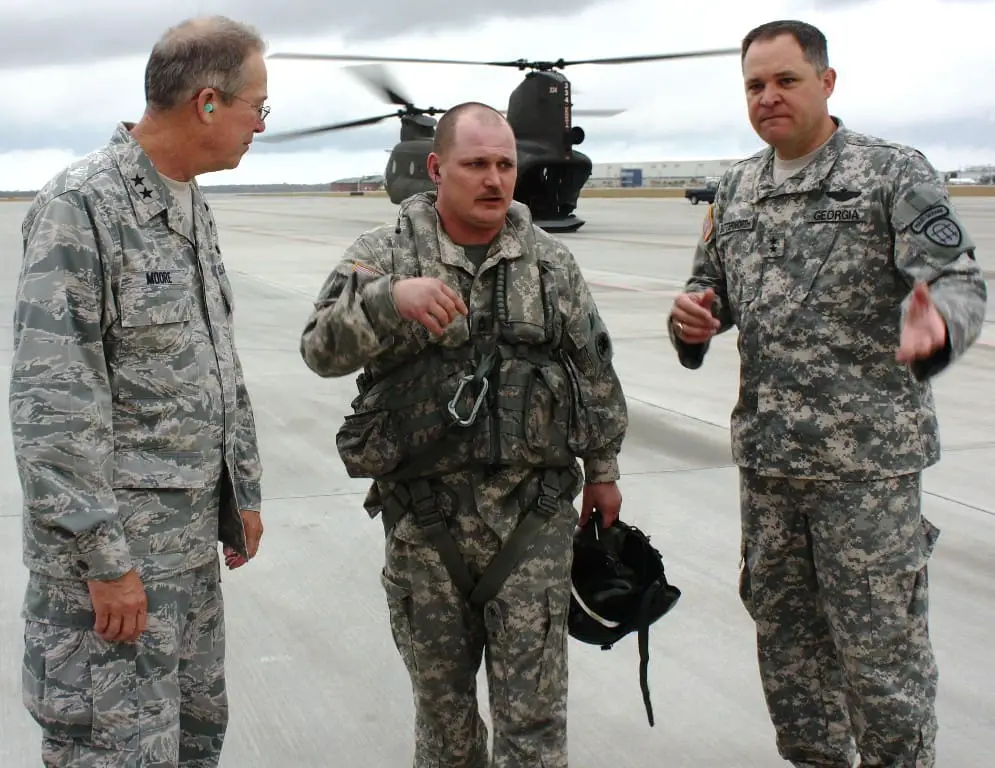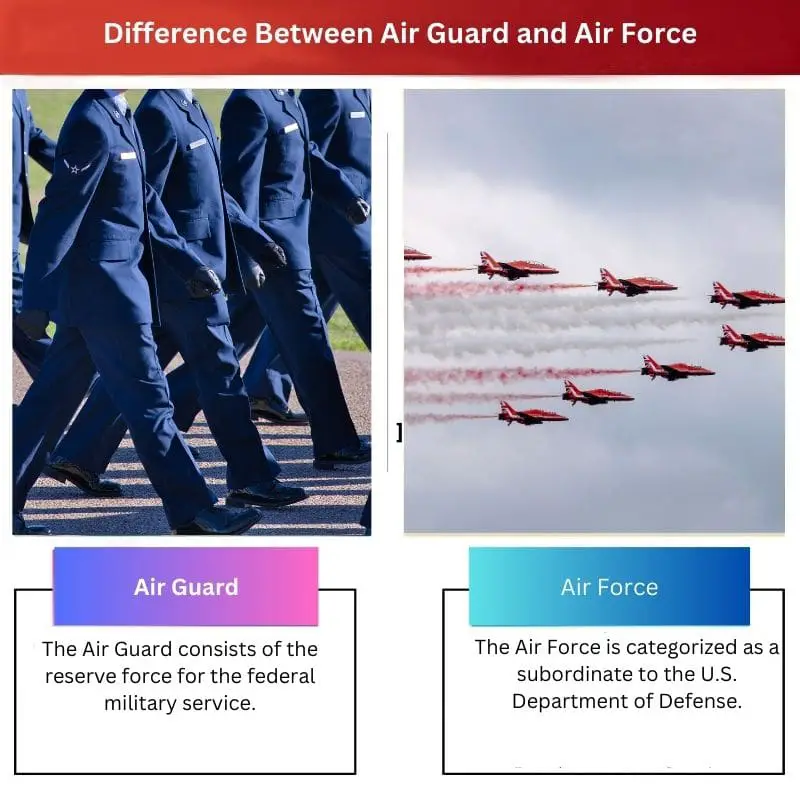Though the terms air guard and air force may sound confusingly similar, several key distinctions separate these divisions from one another.
Both the Air Guard and Air Force are associated with the United States Armed Forces, tasked with the protection of the nation of the United States of America.
These divisions contain loyal members who strive to serve their nation and take pride in their duty.
Key Takeaways
- The Air Guard is a reserve component of the United States Air Force, while the Air Force is the primary aerial warfare service branch.
- Air Guard members serve part-time, balancing military service with civilian life, whereas Air Force members serve full-time and may be deployed worldwide.
- The Air Guard supports domestic emergencies, natural disasters, and homeland defense, while the Air Force focuses on air superiority, global strikes, and rapid global mobility.
Air Guard vs Air Force
The difference between the Air Guard and Air Force is that while Air Guard refers to the reserve force of the federal military service of the country of the United States, the Air Force, on the other hand, refers to the Air Service branch employed by the Armed Forces of the country of United States of America.

Air Guard speaks about the reserve force of the federal military service of the country. They are also commonly called the air militia.
The units pertaining to the United States ANG are subordinate to the governor of the state’s jurisdiction.
Although liberties exist that can allow the Air National Guard to be associated with the Air Force if sanctioned by the President of the country of United States.
Air Force refers to one of the prestigious eight uniformed U.S. services. It falls under a separate, individual branch under the U.S. Armed Forces. It makes up a part of one-third quotient of the country’s Department of Defense.
The Secretary of Defense holds the position of power. He/she is selected or nominated by the President and is reported to by the Air Force Secretary.
Comparison Table
| Parameters of Comparison | Air Guard | Air Force |
|---|---|---|
| Definition | The Air Guard consists of the reserve force for the federal military service. | The Air Force is categorized as a subordinate to the U.S. Department of Defense. |
| Headed By | The Air Guard falls under the State Governor’s jurisdiction. | The Air Force is presided over by the U.S. Secretary of Air Force. |
| Size | 107,414 airmen and 1,080 aircraft. | 350,000 active duty personnel and 5800 aircraft. |
| Belongs To | The U.S National Guard Bureau | The Armed Forces of the U.S |
| Headquarters | The Pentagon, Virginia | The Pentagon, Virginia |
What is the Air Guard?
Air Guard refers to the Air National Guard. This division signifies the reserve service team or force of the federal military of the country of the United States of America.
They are also referred to as the country’s air militia.
The units pertaining to the ANG are categorized below the governor of the state’s area of jurisdiction.
However, liberties and provisions allowing the Air National Guard to work alongside the Air Force exist if sanctioned by the President.
This reserve service includes an impressive 107,414 airmen and 1,080 aircraft in its possession.
These men and women of honour are kept at their peak potential by having the members go on active duty training two weeks a year and with regular drill weekends every month.
The Air National Guard has its headquarters within the premises of The Pentagon, Arlington County, Virginia, arguably one of the most powerful areas in the country.
The Air National Guard falls under the call of the United States National Guard and the National Guard Bureau. And is tasked with providing the Air Force with ready-to-combat personnel and aircraft.
The Air National Guard locations may vary within air force or National Guard bases, reserve bases, naval air stations, and/or independent military facilities. They protect and support their respective states.

What is the Air Force?
The Air Force deigns to occupy one of the eight uniformed U.S. services. It is a military branch of service that is in lieu of the Air Force Department of the country.
It fills and makes up a part of one-third of the nation or country’s Department of Defense.
The Air Force is presided over by the civilian Air Force Secretary.
The position of power is held by the Secretary of Defense, who is selected or nominated by the President and is reported to by the Air Force Secretary.
Several ranks exist within the Air Force, the most poignant being the Chief of Staff of the members belonging to the service. This title holds the card to the highest-ranking officer in the esteemed Air Force Department.
The Air Force falls under a separate, individual branch under the U.S. Armed Forces.
With a whopping 350,000 active duty personnel, 5800 aircraft, and 110,000 air national guard personnel, the Air Force commands huge respect.
It is headquartered in The Pentagon, Arlington County, Virginia, with air superiority, rapid global mobility, global strike, surveillance and reconnaissance, and command and control.
They serve the nation around the clock with blue and yellow colors, fearless and faithful.

Main Differences Between Air Guard and Air Force
- Air Guard refers to the federal military service’s reserve force from the country of United States of America, whereas Air Force is a branch of military service that is in lieu of the Air Force Department.
- The Air Guard consists of 107,414 airmen and 1,080 aircraft. The Air Force holds an eye-bulging 350,000 active duty personnel and 5800 aircraft in its possession.
- The Air Guard falls under the control of the U.S. National Guard and the country’s Bureau of National Guard. Its counterpart, the Air Force, rests under the Armed Forces of the country of the U.S.
- The Air Guard is situated under the area of authority belonging to the State Governor. Parallelly, the Air Force is controlled or looked over by the Secretary of the Air Force.
- A pivotal difference between the two is that while ANG stands for a narrower concept, the Air Force comprises the ANG and is, therefore, a much wider concept.

- https://books.google.com/books?hl=en&lr=&id=UJDfAAAAMAAJ&oi=fnd&pg=PP4&dq=air+national+guard&ots=m5mOzg7zDz&sig=F20hZDIA9SM_uMP3eokHxw2CWGY
- https://www.tandfonline.com/doi/abs/10.1057/jors.1987.25

The information is extremely helpful and detailed. I’m grateful for this knowledge, as now I’m certain about the differences between the two divisions.
It was so confusing for me to differentiate between the two. This article has been an eye-opener.
We should be grateful to those who serve in either of these divisions, keeping us secure.
The difference is clear, that’s the most important thing.
Knowledge is power.
How can anyone be confused with this information? It’s very clear.
It is crucial for citizens to have awareness of these two divisions which help in the protection of the nation.
The content is exceptional and valuable.
Too much information can sometimes be overwhelming.